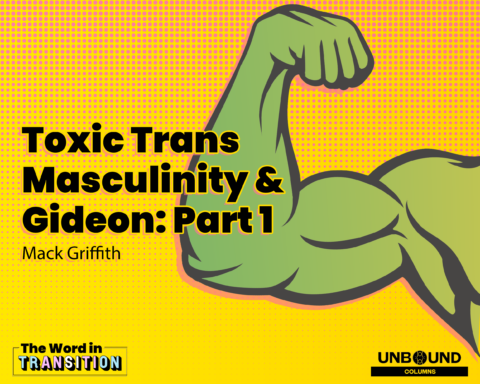Abstract
The scene of Jesus’ transfiguration in Mark 9:2-8—not only Peter’s address to Jesus as “rabbi” and his offer to build tabernacles for Jesus, Moses, and Elijah (Mark 9:2-8) but also God’s affirmation of Jesus’ identity—offers instruction of allyship. Peter’s inappropriate response to Jesus’ transformation parallels poor allyship in which a cisgender person inappropriately identifies a transgender person and/or assumes the trans person’s needs. In contrast, the heavenly voice, which identifies Jesus as beloved son and instructs the disciples to listen to Jesus, models an ally who appropriately refers to a transgender person and encourages listening to determine what form of support the trans person needs most.
Mark’s account of Jesus’ transfiguration demonstrates how allies can assume appropriate responses rather than take time to listen. In Mark 9:2-8, Jesus takes Peter, James, and John up a mountain, where Jesus is transfigured (NRSV) before them. The three disciples watch as Jesus’ clothes become brilliant white, and Elijah and Moses appear with him. Shocked and unsure of what to say, Peter tells Jesus that it is good for him to be there and offers to set up tabernacles for Jesus, Moses, and Elijah. Suddenly, a voice from heaven speaks, “This is my Son, the Beloved; listen to him!” Peter’s inappropriate response and the correct response of the heavenly voice offer, respectively, less helpful and more helpful models of allyship.
Upon witnessing the revelation of Jesus’ divine nature, Peter offers what Mary Ann Beavis calls an “awkward reaction” calling Jesus “rabbi.” The term “rabbi” appears only 3 times in the gospel of Mark, this being the first occurrence. The second is Peter’s response to the withered fig tree (11:21) and the third is Judas’ betrayal of Jesus (14:45). While “rabbi” is a title a respect, Jesus has referred to himself as “Son of Man” 4 times by this point in the gospel making “rabbi” inappropriately ordinary in response to such a supernatural experience.[1]
Peter’s suggestion of building tabernacles (9:5), however, is not completely foolish. Peter could have in mind a place of honor or sacrality or even a place of protection since Jesus has already predicted his death in 8:31. Edwards notes that Peter’s suggestion of tabernacles would be fitting if he is aware of prophecies that foretell the return of Elijah (Malachi 4:5) and the establishment of a new temple (Ezekiel 40) at the start of the Messianic Age.[2] Mark, however, does not explain Peter’s suggestion and instead notes that Peter does not know what the appropriate response is (9:6)—a very common occurrence for allies when a trans person come out to them. Peter is instructed on the proper response in the next verse when a voice from heaven declares, “This is my Son, the Beloved; listen to him” (9:7). This voice not only identifies Jesus properly as the Son of God, but also tells the disciples what they ought to do: listen. Peter’s first response may not have been completely foolish, but it is also not what Jesus needs from his disciples. Jesus needed his disciples to learn from their teacher—by listening and asking questions. Instead of asking questions or listening to what Jesus would say about his own transfiguration, Peter assumes what would affirm Jesus and respect his revealed identity.
The term the NRSV renders “transfiguration” is μεταμορφόω, the word from which “metamorphosis” is derived. Metamorphosis describes a “change of physical form, structure, or substance especially by supernatural means” or “a striking alteration in appearance, character, or circumstances”. According to James R. Edwards, this metamorphosis does not “signify a change in Jesus’ nature, but rather an outward visible transformation of his appearance to accord with his nature.”[3] Thus, in front of his disciples, Jesus’ appearance changes and reveals the divine nature that was already within him. Mark’s use of “metamorphosis” language offers a helpful outlook on trans people’s transitions. Physically transitions through hormones, surgery etc. does not change who the trans person is—their nature remains unchanged, but their body/appearance is altered to match their nature.
Like Jesus’ transfiguration/metamorphosis, coming out as a transgender individual is an extraordinarily complex experience. On one hand, I was telling my loved ones that I would be changing my name and my appearance—essentially changing how the world perceived me. On the other hand, I was assuring them that I had always been myself and would continue to be myself even though they had never seen me in that way before. Some of the people to whom I came out were shocked, some were scared, and many, like Peter, did not know what to say or do. Many had good intentions, but not all responded appropriately. A few friends told me that they had always known and were not surprised: this response validated my identity even as it invalidated the difficulties of coming out. Some said they were shocked but wanted to support me, but I would always be *insert deadname here* to them. This response was hurtful, because they refused to acknowledge my identity. Others made assumptions about what I would find affirming and so greeted me with attempted compliments like, “wow, you look so masculine today!” These friends had the best intentions, and they wanted to love and affirm me, but their affirmations felt ingenuine and increased my dysphoria as I wondered about their actual impressions of me. Their well-intentioned affirmations left me wondering if I was only masculine on the days when I dressed a certain way or if I did not look masculine at all and they were only pandering to how they knew I wanted to look. At these moments, I wanted a voice from heaven to announce my identity to my friends and to tell them to listen.
Even without the heavenly voice, some of the people to whom I came out had helpful responses. One friend, who played an instrumental role in helping me figure out my identity, responded by telling me that she loved and supported me. Then she asked questions: what name I wanted to be called, what pronouns I wanted to be used, how I was feeling about coming out, and how she could support me. Occasionally she would ask an inappropriate question, but when I told her that her question was too personal or something she should google rather than ask, she apologized and learned from that mistake. My friend responded in the way Peter should have responded to Jesus—she asked questions and took the time to learn. When I asked her if I could share our story in this article, she happily agreed; as she said, “Ignorance doesn’t get you a gold star, and asking questions can be compassion.”[4]
No voice from heaven came for me to my friends and family, but that does not mean that I never received divine confirmation of who I am. When I was in college, our small underground LGBTQ+ student group drove a few times a semester to an affirming church in Pittsburgh, PA where we would join for the service and speak with their LGBTQ+ Christian support group. That church was my first experience with an affirming congregation, and praying from their pulpit was the first time I served in a church as my full self. One Sunday in the support group, the facilitator asked us to close our eyes and imagine what our all-loving God might say to us. I closed my eyes and felt the divine presence in a way I had not experienced since I was a child. I felt a hand on my shoulder and a voice in my head saying, “You are my son, and I love you.” Surrounded by allies and friends, and with tears in my eyes, I knew that even though there would be future suffering, I had an ally in my Creator and allies in the people God placed in my life.
Being an ally sometimes can feel like a guessing game. Wanting to say the right thing and to avoid saying the wrong thing can feel like an impossible task. The transfiguration of Jesus teaches us what it takes to be a good ally to a transgender person—willingness to listen to the trans person about their identity as well as how you can best support them. The ally in doubt, might imagine the heavenly voice providing guidance— “This is my child, the beloved; listen to them.”
[1] Mary Ann Beavis, Mark, Paideia: Commentaries on the New Testament (Grand Rapids: Baker Academic, 2011), 137.
[2] James R. Edwards, The Gospel According to Mark, Pillar New Testament Commentary (Grand Rapids: Eerdmans, 2002), 266.
[3] MERRIAM-WEBSTER.COM DICTIONARY, s.v. “Definition of METAMORPHOSIS.”
[4] Caroline Baker, “When I Came out as Transgender, What Did You Feel and What Were Your Thoughts?” Text Message, 26 April 2021.

Mack Griffith (he/him/his) is transgender biblical scholar, poet, and 2021 Master of Theological Studies graduate of Vanderbilt Divinity School. After graduating from Vanderbilt Divinity School, he will go on to complete a Ph.D. in New Testament biblical studies through St. Mary’s University, Twickenham. Mack’s field of interest is transgender biblical studies, and he hopes to progress transgender biblical readings beyond defense of trans identities to readings that offer representation, hope, and empowerment to the transgender community.






Unbound Social